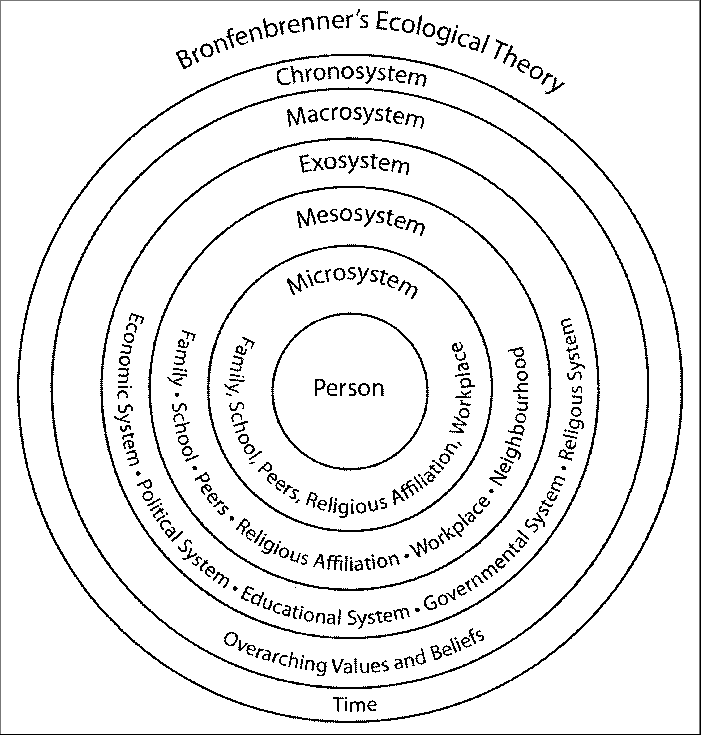What is Ecological Systems Theory?
Ecological Systems Theory (EST) was first developed by Urie Bronfenbrenner, a developmental psychologist, in the 1970s. It explains how individuals interact with their environment.

Ecological Systems Theory (EST) was first developed by Urie Bronfenbrenner, a developmental psychologist, in the 1970s. It explains how individuals interact with their environment. According to Bronfenbrenner, the environment plays a crucial role in shaping human development, and this environment can be divided into multiple levels. The theory posits that various environmental factors, such as family, school, community, and culture influence an individual's development.
The ecological systems model is widely used in research on child development but has also been applied to other areas such as education, health care, and social work.
💡 Lessons learnt: Our environment influences our mindset.
The Ecological Systems Model
Bronfenbrenner proposed that the environment can be divided into different levels, each of which has a unique impact on an individual's development.
The first level of the ecological systems model is the Microsystem, which refers to an individual's immediate environment. This includes family, school, peers, and any other immediate social interactions that an individual has. The microsystem is considered the most influential level as it directly shapes an individual's development. Imagine Alex, a 9-year-old elementary school student who lives with his parents and younger brother in a middle-income neighborhood. At the microsystem level, Alex's family plays a positive role in his development. His parents provide emotional support and guidance, which are important for his social development. They also engage in regular family activities such as game nights and outdoor activities, which promote bonding and positive family dynamics.
The second level is the Mesosystem, which refers to the interrelationships between different microsystems. For instance, a child's development may be influenced by the interaction between their parents and school. At the mesosystem level, Alex attends a well-resourced school with experienced teachers who provide individualized attention and support. His parents are always informed through an application provided by the school and actively involved in his school activities, attending parent-teacher conferences.
The third level is the Exosystem, which includes external systems that indirectly impact an individual's development. These can include government policies, community resources, and media. At the exosystem level, Alex's family has access to community resources such as scholarships, healthcare facilities, recreational facilities, and after-school programs. They also live in a safe neighborhood with low crime rates and access to public transportation.
The fourth level is the Macrosystem, which refers to the broader cultural context in which an individual lives. This can include societal values, beliefs, and customs. At the macrosystem level, societal attitudes towards education and supportive parenting promote positive outcomes for Alex. His parents value education and encourage him to pursue his interests and passions.
Finally, the Chronosystem refers to changes in an individual's environment over time. These can include historical events or changes in an individual's life circumstances. At the chronosystem level, changes in Alex's family circumstances such as his parents' job promotions or moving to a new city may provide new opportunities for growth and development.

Each level of the environment interacts with and influences the others, ultimately shaping an individual's development.
Applications of Ecological Systems Theory
The ecological systems theory has been applied in various fields, including child development, education, health care, and social work. The theory is used in child development to understand how different environmental factors influence a child's development. Researchers have used the ecological systems model to study topics such as the impact of poverty, parenting practices, and school environments on child development.
In education, the ecological systems theory has been used to study how different levels of the environment impact student outcomes. Researchers have studied the influence of classroom environments, teacher-parent relationships, and school-wide policies on academic achievement.
While the ecological systems theory provides a valuable framework for understanding human development, it is also subject to certain limitations. For instance, a popular known limitation is its lack of specificity: The ecological systems theory is a broad framework that focuses on the interaction between an individual and their environment. However, it does not provide specific guidance on how to address individual challenges or provide targeted interventions.
Understanding such limitations will help educators and policymakers refrain from making broad generalizations and use them in conjunction with other theories and frameworks to gain a comprehensive understanding of human development.

Adiutor
Adiutor means "helper" - we do just that, by taking a load of your school administration and helping you focus on what matters most: the kids.
References:
Bronfenbrenner, U. (1979). The ecology of human development: Experiments by nature and design.
Stanger N.(2011). Moving “eco” back into socio-ecological models: A proposal to reorient ecological literacy into human developmental models and school systems
Bronfenbrenner, U., & Morris, P. A. (2006). The bioecological model of human development. Handbook of child psychology, 1-793.
Mistry, R. S., Vandewater, E. A., Huston, A. C., & McLoyd, V. C. (2002). Economic well-being and children's social adjustment: The role of family process in an ethnically diverse low-income sample. Child development, 73(3), 935-951.
Sameroff, A., & Chandler, M. J. (1975). Reproductive risk and the continuum of caretaking casualty. Review of Child Development Research, 4(4), 187-244.
